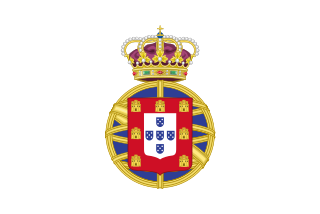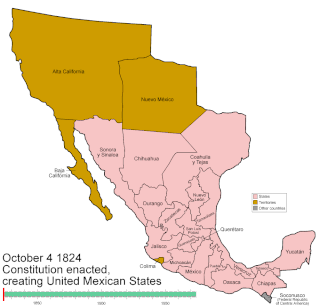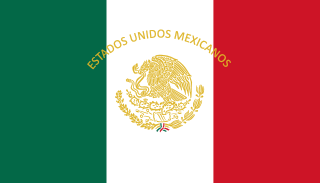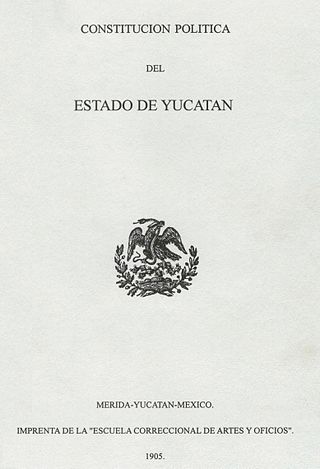
The United Mexican States is a federal republic composed of 32 federal entities: 31 states and Mexico City, an autonomous entity. According to the Constitution of 1917, the states of the federation are free and sovereign in all matters concerning their internal affairs. Each state has its own congress and constitution.
Promulgation is the formal proclamation or the declaration that a new statutory or administrative law is enacted after its final approval. In some jurisdictions, this additional step is necessary before the law can take effect.

A constituent assembly is a body assembled for the purpose of drafting or revising a constitution. Members of a constituent assembly may be elected by popular vote, drawn by sortition, appointed, or some combination of these methods. Assemblies are typically considered distinct from a regular legislature, although members of the legislature may compose a significant number or all of its members. As the fundamental document constituting a state, a constitution cannot normally be modified or amended by the state's normal legislative procedures in some jurisdictions; instead a constitutional convention or a constituent assembly, the rules for which are normally laid down in the constitution, must be set up. A constituent assembly is usually set up for its specific purpose, which it carries out in a relatively short time, after which the assembly is dissolved. A constituent assembly is a form of representative democracy.

The president of the Republic of Costa Rica is the head of state and head of government of Costa Rica. The president is currently elected in direct elections for a period of four years, which is not immediately renewable. Two vice presidents are elected in the same ticket with the president. The president appoints the Council of Ministers. Due to the abolition of the military of Costa Rica in 1948, the president is not a commander-in-chief, unlike the norm in most other countries, although the Constitution does describe him as commander-in-chief of the civil defense public forces.
A decree is a legal proclamation, usually issued by a head of state such as the president of a republic, or a monarch, according to certain procedures. It has the force of law. The particular term used for this concept may vary from country to country. The executive orders made by the President of the United States, for example, are decrees.

The Mexican Empire was a constitutional monarchy, the first independent government of Mexico and the only former colony of the Spanish Empire to establish a monarchy after independence. It is one of the few modern-era, independent monarchies that have existed in the Americas, along with the long-lasting Empire of Brazil (1822–1889) and the ephemeral First Empire of Haiti (1804–1806). It is typically denominated as the First Mexican Empire to distinguish it from the Second Mexican Empire of Emperor Maximilian (1864–1867). Although Mexico became a republic in 1824, it did so only after the failure of the empire under former military officer Agustín de Iturbide, who ruled as Agustín I, the sole monarch of this first empire. Monarchy was the default position for independent Mexico, called for in the political Plan of Iguala drafted by Iturbide, which united forces fighting for independence from Spain. The last Spanish viceroy signed the Treaty of Cordoba in September 1821 and the plan for monarchy in independent Mexico moved forward. Iturbide's popularity culminated in mass demonstrations on 18 May 1822, in favor of making him emperor of the new nation in the absence of any European royal agreeing to assume the throne. Congress approved the proposal and a sumptuous coronation ceremony followed in July 1822.

The Federal Constitution of the United Mexican States of 1824 was the first constitution of Mexico, enacted on October 4 of 1824, inaugurating the First Mexican Republic.

There were three Imperial Orders of the Mexican Empire, which were Orders of chivalry created to reward Heads of state and prominent people during the two periods of the Mexican Empire—the Imperial Order of Guadalupe, the Imperial Order of the Mexican Eagle, and the Imperial Order of Saint Charles.
The Constitution of the Argentine Nation is the basic governing document of Argentina, and the primary source of existing law in Argentina. Its first version was written in 1853 by a constitutional assembly which gathered in Santa Fe; the doctrinal basis was taken in part from the United States Constitution. It was then reformed in 1860, 1866, 1898, 1949, 1957, and the current version is the reformed text of 1994. It's the seventh oldest national constitution currently in effect being ratified on May 1, 1853.

The Mexican Secretariat for Home Affairs is the public department concerned with the country's domestic affairs, the presenting of the president's bills to Congress, their publication on the Official Journal of the Federation, and certain issues of national security. The country's principal intelligence agency, CISEN, is directly answerable to the Secretary of the Interior. The Secretary is a member of the President's Cabinet and is, given the constitutional implications of the post, the most important Cabinet Member. Additionally, in case of absolute absence of the President, the Secretary of Interior assumes the executive powers of the President provisionally. The Office is practically equivalent to Ministries of the Interior in most other countries and is occasionally translated to English as Ministry, Secretariat or Department of the Interior.

The United Kingdom of Portugal, Brazil and the Algarves was a pluricontinental monarchy formed by the elevation of the Portuguese colony named State of Brazil to the status of a kingdom and by the simultaneous union of that Kingdom of Brazil with the Kingdom of Portugal and the Kingdom of the Algarves, constituting a single state consisting of three kingdoms.

Mexico has experienced many changes in territorial organization during its history as an independent state. The territorial boundaries of Mexico were affected by presidential and imperial decrees. One such decree was the Law of Bases for the Convocation of the Constituent Congress to the Constitutive Act of the Mexican Federation, which determined the national land area as the result of integration of the jurisdictions that corresponded to New Spain, the Captaincy General of Yucatán, the Captaincy General of Guatemala and the autonomous Kingdoms of East and West. The decree resulted in the independence from Spain.

The national flag of Mexico is a vertical tricolor of green, white, and red with the national coat of arms charged in the center of the white stripe. While the meaning of the colors has changed over time, these three colors were adopted by Mexico following independence from Spain during the country's War of Independence, and subsequent First Mexican Empire.
The Constitution of the Philippines is the constitution or the supreme law of the Republic of the Philippines. Its final draft was completed by the Constitutional Commission on October 12, 1986, and ratified by a nationwide plebiscite on February 2, 1987.

The president of Mexico, officially the president of the United Mexican States, is the head of state and head of government of Mexico. Under the Constitution of Mexico, the president heads the executive branch of the federal government and is the commander-in-chief of the Mexican Armed Forces. The current president is Andrés Manuel López Obrador, who took office on 1 December 2018.

The Federal Constitution of the United Mexican States of 1857, often called simply the Constitution of 1857, was the liberal constitution promulgated in 1857 by Constituent Congress of Mexico during the presidency of Ignacio Comonfort. Ratified on February 5, 1857, the constitution established individual rights, including universal male suffrage, and others such as freedom of speech, freedom of conscience, freedom of the press, freedom of assembly, and the right to bear arms. It also reaffirmed the abolition of slavery, debtors' prisons, and all forms of cruel and unusual punishment such as the death penalty. The constitution was designed to guarantee a limited central government by federalism and created a strong national congress, an independent judiciary, and a small executive to prevent a dictatorship. Liberal ideals meant the constitution emphasized private property of individuals and sought to abolish common ownership by corporate entities, mainly the Catholic Church and indigenous communities, incorporating the legal thrust of the Lerdo Law into the constitution.

The Political Constitution of the State of Yucatán is the constitution which legally governs the free and sovereign state of Yucatán, one of 31 states with the Federal District comprise the 32 federative entities of the United Mexican States. It was drafted by the Constituent Congress of State, chaired by Héctor Victoria Aguilar in 1918 and promulgated by General Salvador Alvarado, pre-constitutional governor of Yucatán. The most important reforms were made in 1938, although its text has been revised and partially renovated over the 20th century and continues to be reformed so far.

The Regency of the Mexican Empire was a period of transition in the history of the Mexican monarchy in the absence of the Emperor of Mexico and presided by a president of the same during the First Mexican Empire (1821–1823) and the Second Mexican Empire (1863–1867). The regency is the government of a State during the minor age, absence or incapacity of its legitimate prince.
Bases Orgánicas was the name given to the constitution of Mexico which came into effect in 1843. It was the second and final constitution attempted during the Centralist Republic of Mexico, after the Siete Leyes.














